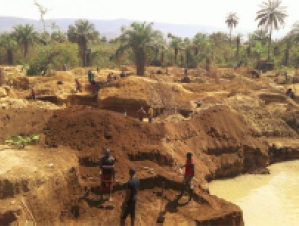
Artisanal diamond mining in Guinea often occurs in areas critical for agriculture: along floodplains, valleys, swamps, and river flats. Miners in Guinea have historically extracted diamonds by pitting, a technique which is extremely harmful to the environment. After the pitting method is employed, the land is no longer productive, resulting in a loss of crops for food and sale. PRADD II introduced SMARTER Mining (Sustainable Mining by Artisanal Miners) to Guinea, building on experience in Liberia and the Central African Republican. SMARTER mining is a technique which provides for a far better and safer way to mine.
The traditional method of pitting involves digging with shovels, axes, machetes, sieves and hand jigs down to the gravel layers, located at depths of up to six meters. The removed material is then washed to search for diamonds, leaving behind sterile gravel which remains in unproductive heaps around the pits many years after activities cease. Although land restoration is required by law, the pitting technique does not include restoration of mining sites. Furthermore, the pitting process washes away fertile top soil, and neither government officials nor customary landowners had been able to bring the land back to productivity. In addition to the unproductive gravel heaps left behind, the pitting process leaves large pits which are an environmental health hazard. These pits are breeding sites for mosquitoes and lead to the spread of other diseases, threatening both humans and livestock. Finally, miners who employ this traditional method of pitting can only access about 65% of the gravel in a pit compared to 90% with SMARTER mining.
SMARTER mining is a bench terracing technique that simultaneously digs and refills the pit. First, the miner removes and sets the rich topsoil. Then, a series of 2-3 meter trenches are dug, first removing the overburden (the layer below the top soil and above the gravel) and finally the gravel itself. As a new trench is dug, the previous trench is filled with the overburden from the current trench. In some cases, washed gravel is mixed with the overburden to ensure that the trench is sufficiently refilled. Once the entire site has been dug in this manner, the topsoil is carefully replaced, restoring the site for productive use and farming can resume almost immediately. Furthermore, in areas where the method has been used, native plant species recolonize very quickly and since the pits are refilled, the environmental health hazard is reduced and there are no piles of sterile material.
Alongside the environmental and public health benefits, SMARTER mining is advantageous for miners to increase both their safety and diamond yield. In contrast to pitting, SMARTER mining allows miners to access and wash about 90% of the gravel. Furthermore, the process is less labor intensive and it improves the structural integrity of the pit, increasing the pit stability and reducing the risk of collapse.
Recently, the PRADD team carried out training and field demonstrations of SMARTER mining in the villages of Gberedabon and Bouramaya. In Bouramaya, fifteen men dug to a depth of 4.5 meters, extracted the diamondiferous gravel, and refilled the site in a single day. In the past, it would have taken the team 7 days using traditional pitting techniques. The owner of the mining claim expressed surprise, for this rapid rate of extraction significantly lessens the costs of mining.Through a training of trainers approach in the nearby village of Gberadabon, 35 miners trained in this bench terracing will likely disseminate the technique even further in the Forécariah District and elsewhere in Guinea.

